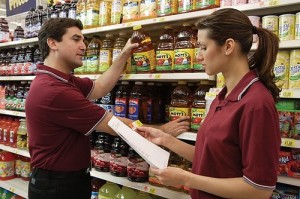Grocery Store Careers Background
 Family celebrations and traditions across the world have one thing in common—food. From a simple breakfast to a home-style Sunday dinner, food is a key ingredient in everyday life as well as the special days of the year. Grandma’s pumpkin pie, Aunt Edith’s banana salad, and Uncle Hubert’s holiday ham are dependent on the availability of ingredients. In the United States, these ingredients are usually purchased at a grocery store or supermarket.
Family celebrations and traditions across the world have one thing in common—food. From a simple breakfast to a home-style Sunday dinner, food is a key ingredient in everyday life as well as the special days of the year. Grandma’s pumpkin pie, Aunt Edith’s banana salad, and Uncle Hubert’s holiday ham are dependent on the availability of ingredients. In the United States, these ingredients are usually purchased at a grocery store or supermarket.
At one time, family farms and gardens provided much of a family’s food supply. As people left the family farms for cities and industrial work, and as families had less time for gardening, food preservation, and food preparation, they became even more dependent on the grocery industry. Full shelves, large selections, and timely deliveries are so typical that the efficiency of the U.S. grocery industry is often taken for granted, even though much of the rest of the world cannot count on such a ready supply of food.
Grocery stores have been a part of life in the United States since the 1800s. At that time, small general stores served towns, cities, and neighborhoods. In some areas, huckster wagons worked independently or for a particular store to deliver groceries to rural areas. This to-your-door service was complemented by specialty deliveries of bread, milk, and more.
In the early 1900s, mom-and-pop grocery stores were prevalent, but some of today’s leading retailers were already expanding. Bernard Kroger, founder of the Kroger Company, already had 40 stores and a factory by 1902. Today, in terms of actual stores, Kroger Company is the largest grocer with 3,323 stores (In terms of annual sales, Kroger is second to only Wal-Mart with 56.9 billion in 2004, according to the Directory of Supermarket, Grocery & Convenience Store Chains 2005). In the early part of this century, many neighborhoods also had several specialty stores, including the butcher’s shop, the bakery, and the delicatessen.
Technology has played a part in the history of the grocery industry. From refrigeration methods to transportation, the industry has integrated the latest technology to improve services and efficiency. One of those technical aspects can be heard in nearly every grocery store. The familiar beep that accompanies checkout lines is due to the innovative bar coding system first developed by Joseph Woodland and Bernard Silver in 1949. The first laser-based scanning system in the United States was installed in a Kroger store in Cincinnati in 1972. While now widely used in other industries, grocery stores were the testing grounds and first users of the Universal Product Code (UPC), which was adopted in 1973.
Today, the trend toward supermarkets and larger grocery stores is growing. According to the Food Marketing Institute, the number of smaller stores continues to fall, while the number of large supermarkets with more than $2 million in annual sales increased from 16,775 in 1987 to 34,052 in 2005. As larger supermarkets move into an area, many smaller stores cannot compete and either go out of business or are purchased by a larger conglomerate. The demise of the local grocery is due not just to supermarkets but also to mass retailers, such as Wal-Mart and Meijer offering both groceries and general ware in their supercenter stores.
Like many other retailers and businesses, mergers and buyouts are constantly changing the names of some local grocery stores, while closing down others. Partially due to those mergers, the total number of grocery stores has declined steadily over the past decade. Shoppers are spending more, but doing so in a smaller number of stores.
Competition in the grocery industry is fierce with many added amenities to lure customers such as in-store coupons, special parking, baby-sitting, restaurants, and specialty areas. Like the small bakeries and specialty shops of the past, large supermarkets now have smaller specialty areas under one roof. Cheese shops, fresh seafood, and pharmacies are some of the specialty areas available. The number of amenities and selection at a store often depend on the store’s location, size, and the competition in the area. Grocery store profits are not excessive; the industry average is only 1.16 percent.
The huckster wagon is returning in a different form. Online grocery stores are cropping up all over the Web, with many companies vying to grab this new market in grocery retailing. The online groceries bring back the days of home deliveries with the added convenience of ordering over the Internet. With total grocery store sales at 478.9 billion in 2005, online groceries have plenty of room to grow. Some online grocers specialize in specific types of food, while others are more diverse. While most traditional grocery stores have Web sites, they do not typically offer online ordering.